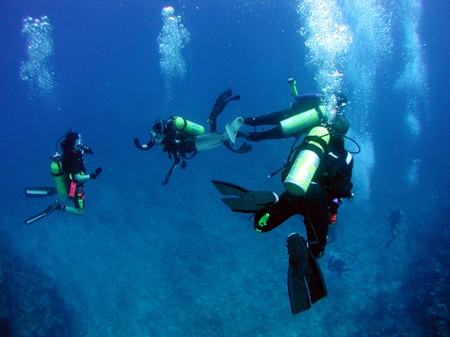Drift diving is what it sounds like – the diver is transported by the currents and can travel great distances beneath the waves.
In the current
Drifting on strong currents is a delight when you know that your dive boat will pick you up after you surface. You move along effortlessly, and the scenery rolls by. You can cover a lot of ‘ground’ in a very short space of time.
It’s important to stay with your buddy when you first submerge and keep together during the dive. Even in clear water, the visibility is such that you can easily be separated. Although you may be only 30 m (100 feet) apart, you’ll be unable to see each other. If one diver stops for a moment, maybe finning back into the current to look at something, the other will carry on.
If you do get separated, the only thing to do is to look for any bubbles heading toward the surface. They may indicate where your buddy is. If you can’t see any, make your way at a safe speed to the surface. Your buddy should have done the same. It may mean that the dive is over at this point, depending on how long you were submerged before you became separated.
On the surface
There’s not much to know about the underwater aspect of drift diving. It’s what happens when you break the surface that is important. Your pick-up boat needs to know where to find you.
In many circumstances, such as when you are diving in a tidal current over flat terrain, you could come to the surface almost anywhere. In this case, it is best to permanently deploy a surface marker buoy (SMB). To do this, you unwind the reel according to your depth, never letting out too much line in case of entanglement. The boat driver simply follows the buoy until you break the surface.
At other times, you may be following a reef or another type of topography that your boat driver is familiar with. In many parts of the world, the locals know the currents extremely well. If this is the case, it may be safe to go diving without having to use a permanent SMB.
When you decide to ascend, you can let the person in the boat know by deploying an SMB. When that breaks the surface, your boat driver will know when and where to expect you.
You should always keep your SMB inflated until You are about to get into the boat, just in case you haven’t been spotted yet, even though the boat may seem to be approaching you to pick you up.
The ocean is a very big place, and you will never feel that more than when you surface and there is no boat nearby.
An SMB is not easily seen from a great distance. Where dive boats have to pick up many divers surfacing in separate groups, you will need a surface marker that is extremely easy to spot and very distinctive. A flag on an extending pole often proves effective for this purpose.
